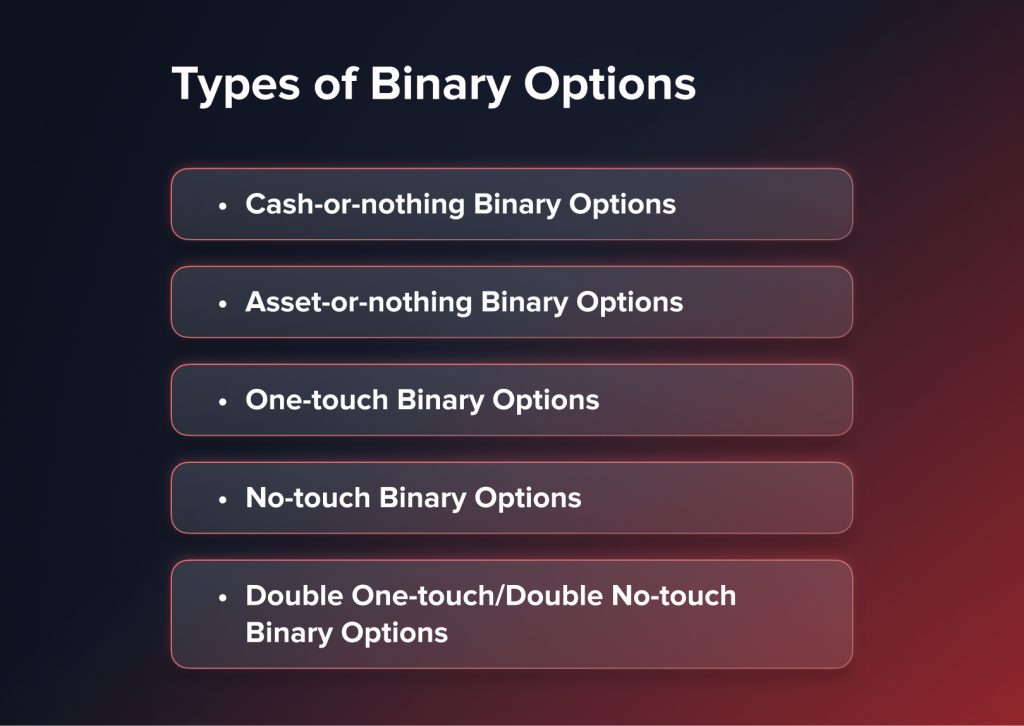
Mastering Binary Options: Types, Strategies, and Risks
Conteúdo
Binary options are a type of financial derivative that offers traders a yes-or-no proposition on the future price of an underlying asset. These options have a clear, preset outcome: a specific monetary gain or a loss. Binary options have grown in popularity, particularly among novice financial traders, owing to its simplicity and appeal of quick returns. However, the traits that make binary options simple and accessible also pose major dangers such as a high chance of losing money and exposure to unregulated platforms that are often fraudulent. To provide prospective traders with an extensive understanding of binary options, this article goes into its mechanics, kinds, methods, and inherent risks and rewards.
Key Takeaways
- Binary options are high risk, short time horizon, with a potential for fixed payout or a total loss based on a yes/no prediction.
- Binary option trade risk/reward is determined BEFORE you can place the trade. However, there is usually a high probability that you lose your entire investment.
- Binary options differ from 'vanilla' options as they have fewer complexity, shorter time horizons, and only two outcomes (either you make money or you don't).
- There are several types of binary options: Cash-or-nothing, Asset-or-nothing, One-Touch Structure, No-Touch Structure, and Double-Touch Structure.
- There are many well-known strategies for trading binary options. Some examples include: Trend-following Trading, Straddle Trading, Risk-Reversal Trading, and Pinocchio Trading. These strategies do not eliminate risk.
- Regions that Trade Binary Options have different levels of regulatory oversight; in fact, many offshore trade platforms, or companies that trade binary options, are a greater risk for the traders & have higher rates of fraud.
- Although binary options offer ease of access and simplicity in their use, traders should confirm trading platform licensing, exercise caution, and use risk management measures when trading binary options.
- The example shown below will further explain how binary options function, which will clarify their payouts.
Definition and Mechanics of Binary Options
Binary options are unique financial products that function on a simple concept, a simplicity that contrasts with traditional put and call option-based structures. Binary options demand a thorough knowledge owing to their dual nature, which provides just two outcomes. The price movement of a particular item, such as a stock, commodity, currency pair, or index, is the basis for binary options, which are based on a straightforward yes-or-no strategy.
As an illustration of a standard binary option, consider the following example: "Will gold cost more than $1,830 at 1:30 p.m. today?" In the event that the condition is satisfied beyond the expiry date, the option will either pay out the specified return or become worthless.
Core Components and Trade Mechanics
Every binary option has basic features like the strike price, a preset price level the asset must either exceed or fall below, and the underlying asset, which forms the basis for the proposition of the option. Moreover, binary options have a set expiration period that could run from minutes to many days or weeks.
When starting a trade, the trader specifies an underlying asset, often drawn from forex trading where liquidity provides fast signals. A strike price, and an expiry period are also specified. The trader then allocates a particular amount of money to the transaction by acquiring the option. This procedure is usually supported by internet trading platforms, which offer an interface for placing transactions. These systems provide the predicted payment %, allowing traders to predict their future gains or losses in advance.
The result of a binary option is decided upon its expiry period. Should the market circumstances match the proposition – that is, if the price of the underlying asset is truly higher than the strike price for a call option – the trader gets a predefined dividend, a proportion of the original investment. On the other hand, should the condition fail, the option expires worthless and the trader loses all the money paid on that transaction.
One of binary options’ distinguishing features is its automatic settlement capability, a mechanism increasingly shaped by algorithmic trading in modern markets. Unlike many conventional trading products, binary options do not need human execution during settlement. Instead, they are meant to conclude instantly, with the trader’s account promptly reimbursed or the deal recorded as a loss.
Binary options attract individuals seeking fast and simple trading possibilities because of its structural simplicity and binary character of the outcomes—where traders either suffer a whole loss or receive a predefined a reward. Nonetheless, its fundamental simplicity also conceals the great dangers involved as the market circumstances are unpredictable and loss is very common. Therefore, anybody thinking about binary options as part of their investment plan should fully grasp these mechanics to properly negotiate the risks.
Types of Binary Options
Binary options are categorized by the conditions and events that determine when they pay out. This gives traders a number of ways to bet on how the market will move or protect current accounts. There are different types of binary options for traders with different risk tolerances and trading styles.

Cash-or-nothing Binary Options
This is the most basic and often traded kind of binary options. Cash-or-nothing options pay out a predetermined amount if they expire "in the money." Basically, if the price of the asset is on the right side of the strike price at expiration, meaning that the trader made the correct call, the trader receives a specified amount of cash. If the option expires "out of the money," the trader will lose the amount deposited.
Asset-or-nothing Binary Options
Asset-or-nothing options are similar to cash-or-nothing options in terms of the conditions that trigger a payment, but they vary in the kind of reward received. If the option expires in the money, the payoff is the value of the underlying asset rather than a preset cash sum. This kind is more like standard options, with a payment that matches the asset's real market price upon expiry.
One-touch Binary Options
Payment will be made to the trader in the event that the underlying object's price reaches a specified level at least once before to the option's expiration. Importantly, unlike traditional options, the trigger for one-touch options is not based on the price at expiry but on the price reaching the amount you specify. When markets are unstable, this type of option is very common because it lets buyers profit from sudden changes in price.
No-touch Binary Options
No-touch options work on the opposite concept as one-touch choices. If the price of the underlying asset does not reach a specific level before the expiry date of the option, a payment is given. This kind is popular among traders who think the asset will move inside a certain range throughout the option term.
Double One-touch/Double No-touch Binary Options
The double one-touch and double no-touch options are more elaborate than the standard one-touch and no-touch alternatives. A double one-touch option pays out if the asset achieves one of two predefined price levels before expiring, which increases the likelihood of a payment in a turbulent market. A double no-touch option, on the other hand, pays out only if the price does not fall below either of the stated thresholds throughout the option's tenure. These are appropriate for situations in which traders anticipate strong volatility but are unclear about the direction.
You may also like

Binary Options vs Vanilla Options
Binary options and vanilla options may sound similar, but they operate very differently. Vanilla options are very flexible with high levels of risk and a variable profit potential, reflecting the complexity of options trading strategies that depend on continuous pricing. They are widely used by institutional traders. Binary options are simpler in structure, time frame and have two possible profit outcomes. It is important to understand these differences so you do not incorrectly interpret binary options as traditional derivatives.
Binary Options vs. Vanilla Options: Comparison Table
| Feature | Binary Options | Vanilla Options |
| Structure | Yes/No prediction with fixed payout | Right to buy/sell at a strike price |
| Outcome | Full payout/full loss | Variable profit/loss depending on market movement |
| Risk | Defined in advance, high chance of total loss | Depends on price movements and greeks |
| Payoff | Binary digital payout | Continuous payoff curve |
| Time Decay | Built into fixed price, expiry heavily impacts outcome | Strong effect, options lose value as expiry approaches |
| Complexity | Very simple with little calculations | Complex with understanding of Greeks, volatility, and pricing models |
| Regulation | Usually unregulated with many offshore brokers | Highly regulated on major exchanges |
| Liquidity | No centralized exchange, depends on the broker | Highly liquid on major exchanges |
| Trade duration | Seconds to hours | Days to months, even years |
| Profit potential | Fixed payout | Large for puts, and unlimited for calls |
| Loss potential | Limited to the initial investment | Can pass premium paid for some advanced strategies |
| Example Scenario | Predict “EUR/USD above 1.0900 in 10 minutes?” | Buy a call option on EUR/USD with strike 1.0900 expiring next month |
Binary Options Trading: Step-by-Step Guide
Binary options trading is simple, however there are lots of risks involved, which usually are overlooked due to how easy binary options trading seems. Below are the steps involved with a typical binary options trade:
1. Select an Underlying Asset
Decide which type of market you want to trade in. There are different markets-foreign currency (Forex), commodity (Gold), indices (stocks), and cryptocurrency (Ethereum). Most Binary Options traders trade very liquid assets which have historically shown more consistent pricing patterns, such as EUR/USD volume and Gold).
2. Select the Expiration Time
Binary options have expiration times of 30 seconds, 1 minute, 5 minutes, or up to an hour or longer. Shorter expiration times, although riskier, tend to attract many new binary options traders seeking quick returns.
3. Set the Strike Price (i.e., Target Level)
The strike price (i.e., target level) is the price level at which your prediction will be based upon. You are predicting whether or not the underlying asset will be above or below the strike price at expiration.
4. Select either a "Call" Option or a "Put" Option
- Call (Up) Option: You are predicting that the price will be above the strike price at expiration.
- Put (Down) Option: You are predicting that the price will be below the strike price at expiration.
This is the "yes" and "no" concept of Binary Options Trading.
5. Choose your Investment Amount
You can select the amount of money that you would like to trade with on a platform, which can typically range from $5 to $1000, but this greatly depends on the trading platform that you choose to use. This is the maximum amount that you can lose.
6. Look at the Payout Percentage
Typically, binary options will provide you with a fixed return, in most cases between 70%-90% on winning trades.
If you make a prediction and are wrong, you will typically lose 100% of your investment.
7. Execute the Trade
After confirming a position:
- The trade will be locked in
- The payout or potential loss will be predetermined
- You will typically be unable to exit your position before expiration.
Some trading platforms may allow for early exit, but at a reduced payout.
8. Wait Until Expiration
At the expiration time, the trade will automatically settle as follows:
- In the Money (ITM): You will receive a fixed payout
- Out of the Money (OTM): You will lose your entire investment
You do not need to manually close your trade when it expires.
9. Review and Analyze Trade Results
After the trade settles:
- Analyze why the trade was successful or unsuccessful
- Analyze charts, volatility and news on the currency, using common market indicators to interpret short-term movements.
- Adjust your strategy to improve future decisions
In order to achieve consistent success with binary options trading, continuously evaluating your trading strategy is imperative; success does not come through luck. It also requires strong trading psychology to avoid emotional decisions.
Sample Binary Options Trading
This example will help illustrate how a binary options trade works. It will describe each phase of a trade on the EUR/USD currency pair and will illustrate an example of both the profitable outcome and the non-profitable outcome.
Setting Up the Trade
- Underlying asset: EUR/USD
- Strike Price (i.e. price level): 1.0850
- Time until expiring: 30 Minutes
- Total Investment Amount: $50
- Payout Percentage of Return: 80% ($40 profit when the trade ends in the money)
Winning Trade Scenario
When setting up this trade, you anticipated that the EUR/USD rate would be higher than 1.0850 at its expiration; therefore, you selected a Call Option as your prediction.
At the end of the trade expiration period (30 minutes later), you would observe the following:
The EUR/USD rate is 1.0862. This is above the strike price (1.0850), which means your prediction was correct.
Thus, you will calculate your payout based on your winning trade.
Payout Calculation:
- 80% (payout percentage) of $50 = $40 profit
- $50 (initial investment) + $40 profit = $90 (total return)
Your net profit on this trade would be $40.
Losing Trade Scenario
In the event that the EUR/USD rate is lower than 1.0850 at expiration,i.e. 1.0837 you would need to state that you were incorrect in your prediction.
The EUR/USD rate of 1.0837 at expiration means that the trade expired out of the money.
The result of this trade was that your entire $50 investment has been lost.
Total Return = $0
Various Trading Strategies
Understanding the principles of the option type is crucial to negotiate the binary options market properly before using deliberate trading strategies. These techniques are supposed to meet different risk tolerances and market beliefs, thereby allowing traders to increase their chances of success and minimize expected losses.
Trend Following Strategy
This is one of the most straightforward and popular strategies for binary options trading. It entails identifying the underlying asset's major trend and trading accordingly. Traders using the trend-following technique would purchase a "call" option on an asset whose value has been gradually increasing. They would do this because they believe the asset will continue to go up until the option expires. The strategy would include a "put" option if the direction is down, which means the price is expected to keep going down. This method is most useful in markets with strong, consistent fluctuations.
Pinocchio Strategy
The Pinocchio method, named after the classic figure whose nose grows when he lies, involves betting against the market when current trends deviate significantly. This technique assumes that extreme swings or "lies" in market prices are corrections that will ultimately return to the mean or reverse entirely. Traders utilizing this approach watch for candlesticks or price bars that deviate considerably from the price movement, signaling a possible reversal. When such a bar appears on a chart, traders will take a position opposed to the current trend.
Straddle Strategy
Because it works so well amid market volatility, the straddle approach is great for binary options trading. This approach entails the trading of both "call" and "put" options on the same asset with the same expiration time. The goal is to capitalize on large changes in either direction. This method becomes beneficial when the asset price moves dramatically in either direction; if the price swings are large enough, one of the options will pay out more than the cost of both holdings, resulting in a net profit.
Risk Reversal Strategy
The risk reversal approach is typically used as a hedging mechanism to protect other assets or transactions. In binary options, this might imply establishing a position opposite to one placed in the conventional market. For example, if a trader has a long position in an asset in the traditional market, they may purchase a "put" option in binary options. This strategy helps to balance possible losses in one market with profits in another, which is especially effective in volatile or unexpected markets.
Each strategy serves a particular goal and is appropriate for a variety of trading styles and market circumstances. By combining a thorough grasp of market dynamics with these strategic techniques, traders may increase their chances of success in the binary options market. However, traders must stay cautious and adaptive, always analyzing their methods in light of market circumstances and making adjustments as needed.
Risks of Binary Options
Binary options trading, while accessible and potentially profitable, carries a set of unique risks and benefits that traders must consider. This dual nature influences individual trading experiences and impacts the overall perception of binary options in financial markets.
Regulatory Concerns
One of the biggest concerns involved with binary options is that many of them are traded on unregulated platforms. This lack of regulation considerably raises the potential of fraud, since traders may use systems with no protection against malpractice. Unregulated platforms may not follow basic financial standards intended to safeguard investors, making it harder to seek solutions in situations of fraud.
All-or-Nothing Outcomes
Binary options are designed to offer either a specific monetary sum or nothing at all, depending on whether a predefined condition is satisfied. If the proposition is not met, this all-or-nothing structure might result in a complete investment loss. Such results mean that, although the risks are limited to the original investment, there is a substantial possibility of losing the whole investment if the market does not move as expected.
Market Volatility
Binary options are often subject to rapid and substantial price changes in their underlying assets. This volatility may have a major impact on trading outcomes, especially as options approach expiry. Volatility may unexpectedly change apparently strong positions into losers, complicating the approach and possibly resulting in quick financial loss.
You may also like

Is Binary Options Trading Legal?
Numerous countries regulate binary options trading differently. Some do not allow traders to trade binary options because of fraudulent trading practices and lack of investor protection. Other countries permit binary option trading, but with heavy regulations and through licensed financial exchanges. Therefore, before you open an account to trade with your selected broker, be sure to understand your regulatory environment, including the role of KYC providers in maintaining compliance.
Countries in which Binary Options are Regulated
United States
- Retail traders (those who do not trade on behalf of a company) are prohibited from trading with offshore binary options brokers.
- In the US, retail traders can only trade binary options through CFTC-regulated exchanges, like Nadex and Cantor Exchange.
- If a retail trader uses an unregulated offshore broker to trade binary options, it is a violation of federal law.
European Union
- The European Securities and Markets Authority (ESMA) has placed a permanent prohibition on the ability of retail traders in the EU to trade binary options.
- In the EU, retail traders are unable to engage in trading binary options with all brokers, except in a very limited case for professional accounts.
- Regulatory bodies such as CySEC, BaFin, and AMF hold EU brokers responsible for compliance with this regulation.
United Kingdom
- The Financial Conduct Authority (FCA) has placed a complete ban on the ability of retail clients to trade binary options within the UK.
- The only way for a trader to engage with binary options is through institutional/professional classification.
Countries with Partial Regulation
These countries permit the transaction of binary options; however, while it is permitted, it is subject to requirements that vary by jurisdiction:
Australia
- In 2021, the Australian Securities and Investment Commission (ASIC) imposed a Real Estate Investment Trust ban and implemented similar regulations as the European Securities and Markets Authority (ESMA) for Binary Options.
- Traders must be classed as Professional to access binary options.
Canada
The Canadian Securities Administrators and the majority of the provinces do not permit the use of binary options.
Japan
- Binary Options are considered to be lawful, yet they fall under the strict regulatory control of the Japanese Financial Services Agency (FSA).
- Binary options must comply with a series of rules, including minimum expiration periods and the obligation to be completely transparent with regards to pricing.
Israel
The State of Israel has instituted an outright ban on all binary options, both domestically and internationally, and currently prohibits any form of marketing and/or offering binary options.
Countries in which Binary Options are Allowed under Light Regulation
Binary options are traded in certain parts of the world, generally in regions with considerably less regulation, for example:
- St Vincent & the Grenadines
- Marshall Islands
- Vanuatu
Typically, most international binary options brokerage firms are located in countries that provide very light or minimal regulatory requirements and have no licensing requirements, which means they can serve clients on a worldwide basis. Unfortunately, the lack of regulatory compliance means that traders have a significantly greater risk of loss when they trade on these types of accounts.
Benefits of Binary Options
Defined Risk
The disclosed risk of binary options is among its most enticing features. When traders start a trade, they are precisely aware of the potential loss or gain involved. At the beginning of the trade, this preset risk is determined, which helps traders properly manage risk and be ready for any losses. Binary options appeal especially to risk-averse people or those new to financial trading because of its clarity and certainty in risk assessment.
Simplicity
Binary options are known for their simplicity. Unlike traditional options, which have a range of potential outcomes and may need extensive strategy, binary options provide a straightforward proposal. Traders merely need to predict if a certain event will occur, such as whether an asset will be above or below a predetermined price at a particular period. This simplicity makes binary options simpler to understand and trade, especially for people with no trading expertise.
Accessibility
Binary options trading is easily accessible to a wide range of people due to its minimal entry criteria. Many binary options platforms enable traders to join with a small initial deposit, decreasing the barrier to entry when compared to other trading types that may need large resources. This accessibility welcomes new traders and offers a convenient starting point for those wishing to diversify their financial methods without committing significant capital.
Conclusion
Under the correct circumstances, binary options provide a one-of-a-kind trading potential for profit. However, they also pose major hazards that should not be overlooked. Traders must approach this financial instrument with a well-planned strategy and an acute understanding of the possible losses. Educating oneself on the regulatory environment and practicing on demo accounts may also assist reduce some of the dangers involved with binary options trading.
FAQ
Yes, it is possible to profit from trading binary options; however, achieving consistent profits is difficult. The chance of losing your entire investment is high and very few traders achieve consistent profitable results.
Regulators restrict the use of binary options due to the prevalence of fraud within this industry, as well as misleading marketing, and the significant amount of money lost by retail investors.
Only use binary options on a regulated platform (if they are permitted in your region), trade with small position sizes, avoid ultra-short expiry times, and think of binary options as high-risk speculation.
Atualizado:
11 de dezembro de 2025




